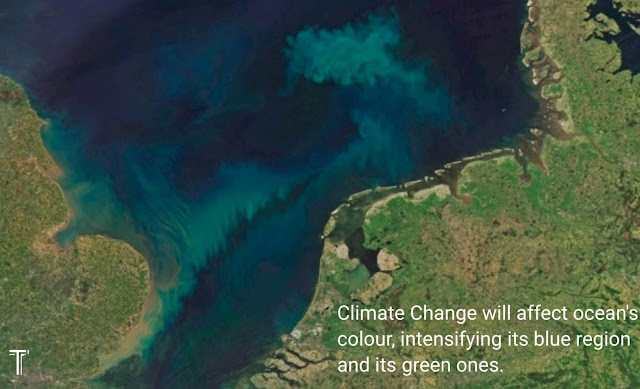CLIMATE CHANGE COULD TURN THE OCEANS BLUER
Warming is causing significant changes to Phytoplankton in the oceans, and over the coming decades it will intensify the blue and green regions of the water bodies.
 |
| CLIMATE CHANGE AND OCEAN |
Much of the surface ocean will shift in colour by end of the 21st century
More than 50% of the world's oceans will shift in colour due to climate change by the year 2100, a Massachusetts Institute of Technology(MIT) study has found.
Climate change is causing significant changes to phytoplankton in the world's oceans, and over the coming decades, these changes will affect the ocean's colour, intensifying its blue regions and its green ones, according to the study published in the journal Nature Communication.
Researchers report that they have developed a global model that simulates the growth and interaction of different species of phytoplankton, or algae, and how the mix of species in various locations will change as temperatures rise around the world.
The researchers also simulated the way phytoplankton absorb and reflect light, and how the ocean’s colour changes as global warming affects the makeup of phytoplankton communities.
Researchers report that they have developed a global model that simulates the growth and interaction of different species of phytoplankton, or algae, and how the mix of species in various locations will change as temperatures rise around the world.
 |
| Image: NASA Earth Observatory |
The researchers also simulated the way phytoplankton absorb and reflect light, and how the ocean’s colour changes as global warming affects the makeup of phytoplankton communities.
Satellites should detect these changes in hue, providing early warning of wide-scale changes to the marine ecosystem, said researches at Massachusetts Institute of Technology(MIT) in the US.
The study suggests that blue colour regions, such as subtropics, will become even more blue, reflecting even less and life in general in those waters, compared with today, such as near the poles, may turn even deeper green, as warmer temperature brew up larger blooms of more diverse phytoplankton.
Reason For change in colour
The ocean's colour depends on how sunlight interacts with whatever it is in the water. Water molecules alone absorb almost all sunlight except for the blue part of the spectrum, which is reflected
back out, researchers said.
This time around, the researchers added a new element to the model, that has not been included in other ocean modelling techniques: the ability to estimate the specific wavelengths of light that are absorbed and reflected by the ocean, depending on the amount and type of organisms in a given region.
Things you need to know about climate change, Scientists and Human activities
This time around, the researchers added a new element to the model, that has not been included in other ocean modelling techniques: the ability to estimate the specific wavelengths of light that are absorbed and reflected by the ocean, depending on the amount and type of organisms in a given region.
 |
| Phytoplankton |
“Sunlight will come into the ocean, and anything that’s in the ocean will absorb it, like chlorophyll,” Researches says. “Other things will absorb or scatter it, like something with a hard shell. So it’s a complicated process, how light is reflected back out of the ocean to give it its colour.”
Relatively barren open-ocean regions appear as deep blue from space. If there are any organisms in the ocean, they can absorb and reflect a different wavelength of light, depending on their individual properties.
Do you Believe Climate Change is real? Cast your opinion here.
According to their model, climate change is already changing the makeup of phytoplankton, and by extension, the colour of the oceans. By the end of the century, our blue planet may look visibly altered.
“There will be a noticeable difference in the colour of 50 per-cent of the ocean by the end of the 21st century,” Researchers says. “It could be potentially quite serious. Different types of phytoplankton absorb light differently, and if climate change shifts one community of phytoplankton to another, that will also change the types of food webs they can support. “
CLIMATE CHANGE IS REAL
This research was supported, in part, by NASA and the Department of Energy.
Post Credit: Press Trust India, MIT

No comments:
Post a Comment